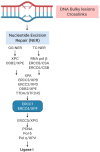Xeroderma Pigmentosum: General Aspects and Management
- PMID: 34834498
- PMCID: PMC8624855
- DOI: 10.3390/jpm11111146
Xeroderma Pigmentosum: General Aspects and Management
Abstract
Xeroderma Pigmentosum (XP) is a rare genetic syndrome with a defective DNA nucleotide excision repair. It is characterized by (i) an extreme sensitivity to ultraviolet (UV)-induced damages in the skin and eyes; (ii) high risk to develop multiple skin tumours; and (iii) neurologic alterations in the most severe form. To date, the management of XP patients consists of (i) early diagnosis; (ii) a long-life protection from ultraviolet radiation, including avoidance of unnecessary UV exposure, wearing UV blocking clothing, and use of topical sunscreens; and (iii) surgical resections of skin cancers. No curative treatment is available at present. Thus, in the last decade, in order to prevent or delay the progression of the clinical signs of XP, numerous strategies have been proposed and tested, in some cases, with adverse effects. The present review provides an overview of the molecular mechanisms featuring the development of XP and highlights both advantages and disadvantages of the clinical approaches developed throughout the years. The intention of the authors is to sensitize scientists to the crucial aspects of the pathology that could be differently targeted. In this context, the exploration of the process underlining the conception of liposomal nanocarriers is reported to focus the attention on the potentialities of liposomal technology to optimize the administration of chemoprotective agents in XP patients.
Keywords: Dimericine; liposomes; nucleotide excision repair; personalized medicine; xeroderma pigmentosum.
Conflict of interest statement
The authors have no conflict of interest to declare. All authors approved the contents of this manuscript.
Figures



References
-
- Bradford P.T., Goldstein A.M., Tamura D., Khan S., Ueda T., Boyle J., Oh K.-S., Imoto K., Inui H., Moriwaki S.I., et al. Cancer and neurologic degeneration in xeroderma pigmentosum: Long term follow-up characterises the role of DNA repair. J. Med. Genet. 2011;48:168–176. doi: 10.1136/jmg.2010.083022. - DOI - PMC - PubMed
-
- [(accessed on 10 September 2021)]. Available online: http://www.orphadata.org/cgi-bin/index.php.
Publication types
LinkOut - more resources
Full Text Sources

